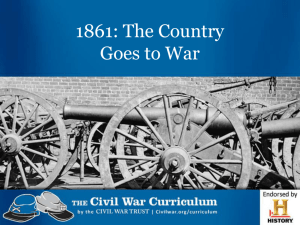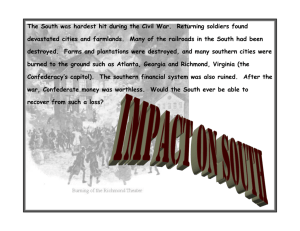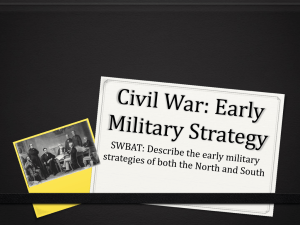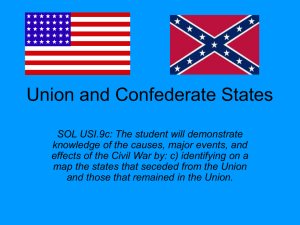Civil War * The South - Edmonds School District
advertisement
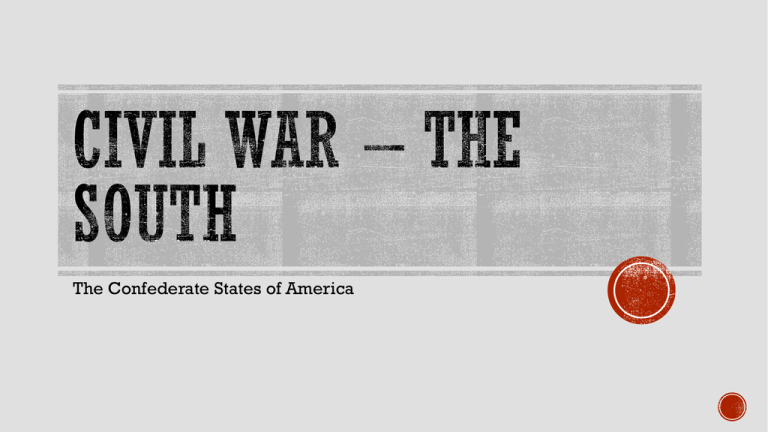
The Confederate States of America The Confederate States of America, also referred to as the Confederacy and the CSA, an unrecognized power established in early 1861 by eleven southern slave states that seceded from the United States of America. South Carolina Mississippi Florida Alabama Georgia Louisiana Texas Virginia Arkansas Tennessee North Carolina issue of slavery these states also had issues with the Federal Government that included: states' rights policies favoring Northern over Southern economic interests expansionism modernization taxes Though many of the disagreements between the North and South had been brewing since the American Revolution ended in 1782, the crisis began to come to a head in the 1850’s as the nation was growing westward. new territories such as Kansas and Nebraska were added the Southern factions felt that slavery should be allowed in these new territories the "Free Soilers” were set against it. This led to open warfare between Kansas and Missouri, generally referred to in history as "Bleeding Kansas.” One of the many precursors to the Civil War, these many battles pitted neighbor against neighbor. The secession of Southern states dispute over the expansion of slavery into new territories the election of Abraham Lincoln as president on November 6, 1860 Though Lincoln did not propose federal laws making slavery unlawful where it already existed his sentiments regarding a "divided nation” were well known. On December 20, 1860, South Carolina was the first state to secede (leave) within two months, Mississippi, Florida, Alabama, Georgia, Louisiana and Texas followed. February 4, 1861 the Confederate States of America were organized February 9, a provisional government was formed with President Jefferson Davis as President Confederate attack on Fort Sumter on April 12, 1861 Lincoln called for troops on April 15, 1861 four more southern states declared their secession, including Virginia, Arkansas, Tennessee, and North Carolina. The border states of Kentucky and Missouri declared neutrality citizens were divided in their loyalties. Kentucky gradually came to side with the north Missouri remained divided for the duration of the Civil War. The southern parts of modern day New Mexico and Arizona allied with the Confederacy when the Union abandoned federal forts and installations in Indian Territory (Oklahoma), the South claimed this territory. Union loyalists would form a new state called West Virginia, officially admitted to the Union in June, 1863 Broke away from Virginia during the Civil population had mixed loyalties. February 4, 1861 - The Confederate States of America were organized at a congress of delegates from the seceded states of South Carolina, Georgia, Florida, Alabama, Mississippi and Louisiana which met at Montgomery, Alabama A provisional government was established within a few days and on February 9th; Jefferson Davis was made president and Alexander H. Stephens, vice-president. This temporary government was to continue only one year A '"permanent" constitution was drawn during the weeks immediately following, approved by the congress on March 11th and submitted to the conventions of the seceded states. It was promptly adopted though it would not to become effective until February 22, 1862. Texas joined the Confederacy in March Virginia in April North Carolina in May Tennessee and Arkansas in June large portions of Kentucky and Missouri also cast in their lots with the South The area was about 800,000 square miles exclusive of what was held in the Indian Territory and New Mexico the population of these states and parts of states was about 10,000,000 of which 4,000,000 were African-Americans. With this organization accomplished, the Confederate authorities then appointed commissioners to Europe and to the Federal Government to ask for recognition as an independent power. The commissioners appeared in Washington D.C. and demanded jurisdiction over the forts and other property of the older government within the bounds of the seceded states. Confederate Government assumed the jurisdiction of forts and US Gov. property in their boarders Quickly began the organization of an army and a navy made appropriations and loans for these and other purposes without any opposition on the part of the people of the southern states, there was grave dissatisfaction in the mountain districts where slavery had not taken hold The Federal authorities refused to recognize the Confederate agents or to concede any rights concerning the forts or other property. The European powers acknowledged the existence of the new nation, an important concession especially in commercial matters and in the application of the rules of war. It was generally expected that formal diplomatic recognition would soon follow in the North there was a strong party, supported by the great financial interests of New York, which advised that the southern states be allowed to "depart in peace." Even President Abraham Lincoln thought seriously of such a solution of the problem President Lincoln’s decision not to negotiate with the South Injury to northern commerce and manufactures probable difficulties about boundaries probable conflicts of the future Unwillingness to surrender Fort Sumter At the same time the southern leaders began to fear a restoration of the Union Crittenden Compromise Guaranteed slavery south of 36’30 The firing upon Fort Sumter on the night of April 12, 1861, aroused the latent military spirit of both the people of the North and South and war soon followed. The new Confederate Government early troubles of the leaders that made up of men who most had never believed in the wisdom of secession, though most of them acknowledged the right of a state to withdraw from the Union. The first Cabinet men who had either opposed the secession movement Longtime rivals of Jefferson Davis Vice-President Alexander Stephens not on friendly terms with Davis most powerful opponent of secession in the South as late as January, 1861. The first Secretary of State, Robert Toombs Adversary of Davis within months of his appointment, stepped down to join the Confederate Army as a brigadier general in July, 1861. Secretary of the Treasury, Christopher Memminger, fought the separatist movement since 1832; Secretary of War, L. Pope Walker had been a leader of the unionist forces of North Alabama President Jefferson Davis advised South Carolina not to secede as late as November 10, 1860. Albert Sidney Johnston Only one of the great generals who only really believed in the propriety and necessity of the movement. Robert E. Lee had never been a state rights man late in April, 1861, he lamented the "revolution" which the lower South had precipitated. Confederate agents from 1861 to 1865 failed to secure recognition The U.S. Federal Government refused to hold any official communication that could be interpreted as recognition of the existence of the Confederacy as a separate power. In addition, the U.S. Federal Courts held that the Confederate States were "an unlawful assemblage without corporate power." The Confederacy pinned its hopes for survival on military intervention from Europe. The South based their expectations on the fact that Europe, especially England, could not endure the lack of cotton. These expectations would prove mistaken. The U.S. Federal Government made it clear that any diplomatic recognition of the Confederacy meant war with the United States no nation was willing to go to war and would not assist or recognize the Confederacy. The South had the great advantage officers who resigned their commissions in the United States Army to accept commands in Confederate Army. Leaders of great ability and long experience in actual warfare Robert E. Lee Joseph E. Johnston Albert Sidney Johnston Pierre G. T. Beauregard The prestige which these names carried and the confidence which they inspired in the success of the cause had much to do with the rapid formation and successful organization of the armies During the first year of the struggle, the "new nation" more than 400,000 men into the field and began the building of many ships of war During the four years of the war almost 900,000 soldiers were enlisted and equipped Everyone in the South, whether he had favored the movement originally or not, counted it a disgrace not to have a part in the fighting no one in the older southern states would admit that he or any of his family shirked military duty or sent a substitute to the front. Enthusiasm for the cause, early victories in the field, led to the belief that success was only a matter of time. In this confident expectation, the Confederate government grew a debt of $1,500,000,000 A small portion of this huge debt was due to European creditors, almost $10,000,000 rest was a total loss to the people of the South, mainly to those who had been slave owners. The loss in cotton production and export decreased from four million to less than one million bales between 1860 and 1865 and would not again reach its former state of profitableness until 1870. The corporate wealth of railroads and manufacturers was almost wholly lost during the war. At the beginning of the war the South had three main lines of railroad, some of which were extended to deal with the war-time traffic. Cut off from the steel and iron mills of the North and England, the railroad soon ran down and in the end became almost worthless. Throughout the war, troubles in the Confederate Government continued November, 1864 to February, 1865, a strong party in the Confederate Congress, urged the impeachment of Jefferson Davis and the establishment of a military dictatorship with General Robert E. Lee at the head. The refusal of Lee to support the plan prevented a practical attempt at its realization. The Confederate States of America effectively collapsed after Ulysses S. Grant captured its capitol of Richmond, Virginia and Robert E. Lee's army in April, 1865. The remaining Confederate forces surrendered by the end of June, as the U.S. Army took control of the South. After the war, a decade-long process known as Reconstruction began expelled ex-Confederate leaders from office enacted civil rights legislation imposed conditions on the readmission of the states to Congress. The war and subsequent Reconstruction left the South economically weak and it would be years before they would regain prosperity.
